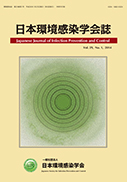Volume 29, Issue 6
Displaying 1-10 of 10 articles from this issue
- |<
- <
- 1
- >
- >|
Review Article
-
2014 Volume 29 Issue 6 Pages 387-395
Published: 2014
Released on J-STAGE: January 26, 2015
Download PDF (5980K) -
2014 Volume 29 Issue 6 Pages 396-404
Published: 2014
Released on J-STAGE: January 26, 2015
Download PDF (4894K)
Original Article
-
2014 Volume 29 Issue 6 Pages 405-410
Published: 2014
Released on J-STAGE: January 26, 2015
Download PDF (315K) -
2014 Volume 29 Issue 6 Pages 411-416
Published: 2014
Released on J-STAGE: January 26, 2015
Download PDF (547K) -
2014 Volume 29 Issue 6 Pages 417-423
Published: 2014
Released on J-STAGE: January 26, 2015
Download PDF (350K)
Short Paper
-
2014 Volume 29 Issue 6 Pages 424-428
Published: 2014
Released on J-STAGE: January 26, 2015
Download PDF (371K)
Report
-
2014 Volume 29 Issue 6 Pages 429-436
Published: 2014
Released on J-STAGE: January 26, 2015
Download PDF (625K) -
2014 Volume 29 Issue 6 Pages 437-443
Published: 2014
Released on J-STAGE: January 26, 2015
Download PDF (462K) -
2014 Volume 29 Issue 6 Pages 444-452
Published: 2014
Released on J-STAGE: January 26, 2015
Download PDF (601K) -
2014 Volume 29 Issue 6 Pages 453-462
Published: 2014
Released on J-STAGE: January 26, 2015
Download PDF (537K)
- |<
- <
- 1
- >
- >|
